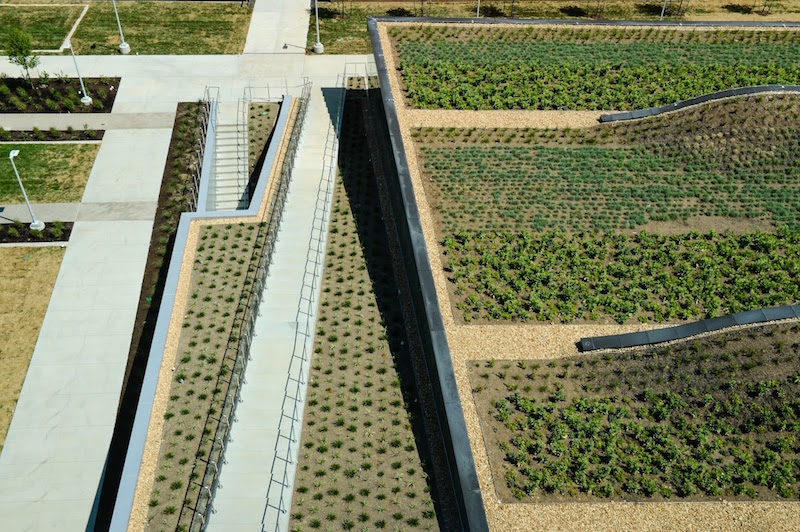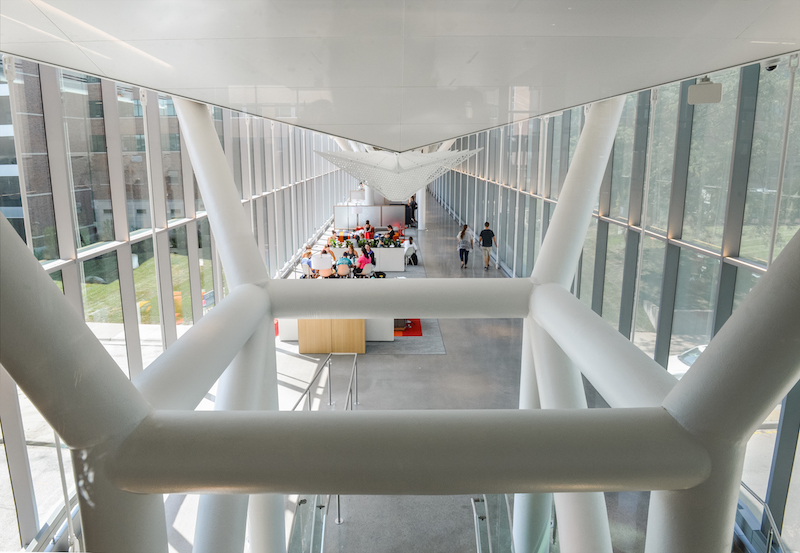Missouri isn’t the only state with a new medical center designed to address the shortage of healthcare professionals, as the University of Kansas Medical Center recently opened the Health Education Building with the same goal in mind.
The Health Education Building is a four-story, 171,000-sf building designed by Co Architects and Helix Architecture that includes high-tech simulation environments and flexible learning studios. Large-scale teaching studios and clinical skills and simulation labs support active, team-based learning.
 Photo courtesy of KUMC.
Photo courtesy of KUMC.
Two 225-person interactive studios are separated by an operable partition that can be removed to create one column-free 11,000-sf event space. The studios and labs “float” within the outer glass façade of the building to show off the core of the building’s curriculum to the public.
From the outside, the building’s design uses a transparent “lantern” box design. The ample use of glass allows students to receive natural daylight and provides them with exterior views.
The Health Education Building’s design also called for an on-grade parking lot to be changed into a 22,000-sf green courtyard and a 17,000-sf vegetated roof with access. The irrigation system for these features uses condensate water from the building’s mechanical system.
 Photo courtesy of KUMC.
Photo courtesy of KUMC.
A 250-foot-long glass-enclosed bridge passes through the center of the Health Education Building and connects it to existing buildings on the Kansas City campus. The bridge links the campus into a loop that provides 6,000 sf of lounge, meeting, and student activity space.
The Health Education Building was designed with flexibility in mind and can accommodate a 25% class size increase over its current enrollment.
 Photo courtesy of KUMC.
Photo courtesy of KUMC.
Related Stories
| Nov 26, 2013
Construction costs rise for 22nd straight month in November
Construction costs in North America rose for the 22nd consecutive month in November as labor costs continued to increase, amid growing industry concern over the tight availability of skilled workers.
| Nov 25, 2013
Building Teams need to help owners avoid 'operational stray'
"Operational stray" occurs when a building’s MEP systems don’t work the way they should. Even the most well-designed and constructed building can stray from perfection—and that can cost the owner a ton in unnecessary utility costs. But help is on the way.
| Nov 19, 2013
Pediatric design in an adult hospital setting
Freestanding pediatric facilities have operational and physical characteristics that differ from those of adult facilities.
| Nov 19, 2013
Top 10 green building products for 2014
Assa Abloy's power-over-ethernet access-control locks and Schüco's retrofit façade system are among the products to make BuildingGreen Inc.'s annual Top-10 Green Building Products list.
| Nov 18, 2013
6 checkpoints when designing a pediatric healthcare unit
As more time and money is devoted to neonatal and pediatric research, evidence-based design is playing an increasingly crucial role in the development of healthcare facilities for children. Here are six important factors AEC firms should consider when designing pediatric healthcare facilities.
| Nov 15, 2013
Greenbuild 2013 Report - BD+C Exclusive
The BD+C editorial team brings you this special report on the latest green building trends across nine key market sectors.
| Nov 15, 2013
Pedia-Pod: A state-of-the-art pediatric building module
This demonstration pediatric treatment building module is “kid-friendly,” offering a unique and cheerful environment where a child can feel most comfortable.
| Nov 14, 2013
Behind the build: BD+C's 'Pedia-Pod' modular pediatric patient unit at Greenbuild 2013 [slideshow]
Next week at Greenbuild, BD+C will unveil its demonstration pediatric patient unit, called Pedia-Pod. Here's a behind-the-scenes look at the construction of this unique modular structure.
| Nov 13, 2013
Installed capacity of geothermal heat pumps to grow by 150% by 2020, says study
The worldwide installed capacity of GHP systems will reach 127.4 gigawatts-thermal over the next seven years, growth of nearly 150%, according to a recent report from Navigant Research.
| Nov 8, 2013
Oversized healthcare: How did we get here and how do we right-size?
Healthcare facilities, especially our nation's hospitals, have steadily become larger over the past couple of decades. The growth has occurred despite stabilization, and in some markets, a decline in inpatient utilization.

















